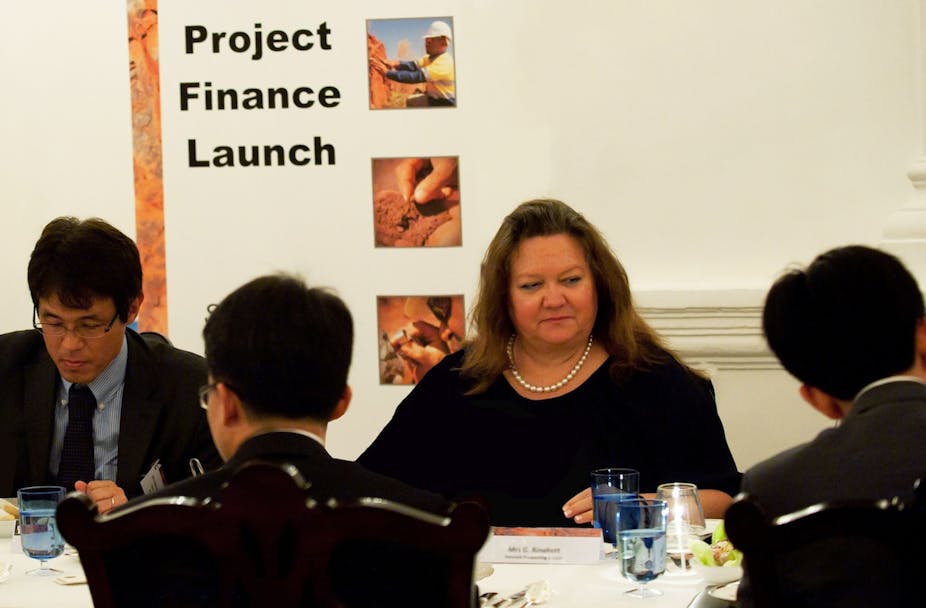When Gina Rinehart’s Roy Hill mine proposal secured the multi-billion dollar financing deal needed to proceed last week, questions were asked about the US$694.4 million coming from the US Export-Import Bank.
Similar to the export credit agencies of many other governments, the Export-Import Bank of the United States (Ex-Im Bank) is the official export credit agency of the US government.
For the benefit of the US…
The US Ex-Im Bank’s mission is pretty standard for government export credit agencies, that is to assist in financing the export of US goods and services to international markets, to help to maintain and create US jobs and contribute to a stronger national economy.
The Bank aims to fill gaps in trade financing by assuming credit and country risks that the private sector is unable or unwilling to accept, and to match the financing that other governments provide to their exporters.
It also extends credit to exporting firms and provides insurance for their trade activities, with 85% of its transactions directly benefiting US small businesses, according to the Bank’s website.
The US$600 billion of US exports, primarily to developing markets worldwide, the Bank claims to have enabled during 80 years is pretty small in the scheme of things, especially considering the large size of the US economy. US GDP is currently estimated at over US$17 trillion in 2013 and even its relatively small export sector of less than 10% of the economy is still worth over US$1.5 trillion.
But all countries play this game
Loans from the government export credit agency of a country mainly take the form of extending credit which allows foreign firms to import from the domestic firm, thereby guaranteeing the proceeds to the domestic firm. Accordingly the US Ex-Im Bank might be expected to target Australian companies which would import goods and services from US companies. Hence the extension of credit so that Gina Rinehart’s Roy Hill Holdings can purchase equipment from US firms in order to develop the Roy Hill iron ore project.
In 2013 Australian companies got over 1.5% of the US Ex-Im Bank’s global total of export credits of over US$19 billion. This is roughly in proportion to Australia’s contribution to world trade. In 2013 Australia came just halfway down the list of 40 countries ranked according to the amount of US export credits obtained. Germany, UAE, Indonesia, Mexico, China-HK, UK and India received US credits of over US$1 billion each in 2013.
It is standard for governments to have an export credit agency to support their countries’ companies in obtaining the finance necessary to fund exporting activities. Almost 40 countries including the industrial countries and China and India have export credit agencies. What’s more the governments of many large economies, for instance Germany and other European and Asian economies, finance a much larger proportion of their exports this way than does the US government.
It has been reported that the Roy Hill project has also secured US$550 million in loans and $US450m in loan guarantees from the Korea Exim Bank, and an additional US$900 million from the Japan Bank for International Co-operation and US$750 million from the Nippon Export and Investment Insurance Corporation.
Such financing is clearly strategic and aligns with political as well as economic interests. That’s the nature of the beast. Moreover gaining export credits largely doesn’t require that firms offer decent working conditions, pay their taxes or meet environmental or other ethical standards. Export credit agencies are in effect not regulated globally.

An Australian policy failing?
One concern is why Roy Hill or any other mining company in Australia needs to import equipment from US companies such as Caterpillar, General Electric and Atlas Copco, rather than Australian manufacturers. This could be seen as arising from an absence or failure of industrial policy in Australia over many decades, to promote and nurture appropriate industrial development.
The result is the decline in the manufacturing sector and a dependence on resource extensive sectors, agriculture and natural resources and energy extraction, and insufficient value adding or innovation activities. By contrast, many other industrial countries can be seen to have comprehensive and successful industrial polices, from Germany to New Zealand.
If winners and losers are created through gaining export credits, this is a matter for Australian government policy.
Has Gina Rinehart’s company received disproportionate US Ex-Im Bank lending relative to other firms in Australia?
While the Roy Hill project is getting nearly US$700 million in export credit and guarantees from the US Ex-Im Bank, in 2013 Qantas got $284 million to import from Boeing. Before that, Australia Pacific LNG Processing got a much larger US$2.9 billion to support Bechtel Power Corp , and Jabiru Satellite got US$281 to support Lockheed and Newsat, and more. The Roy Hill loan is not out of line with these deals.
In small countries like Australia a few companies can often dominate an industry. These are the companies likely to benefit from the export credits of other governments. This increases the already challenging problem of evaluating whether some companies are favoured over others.

